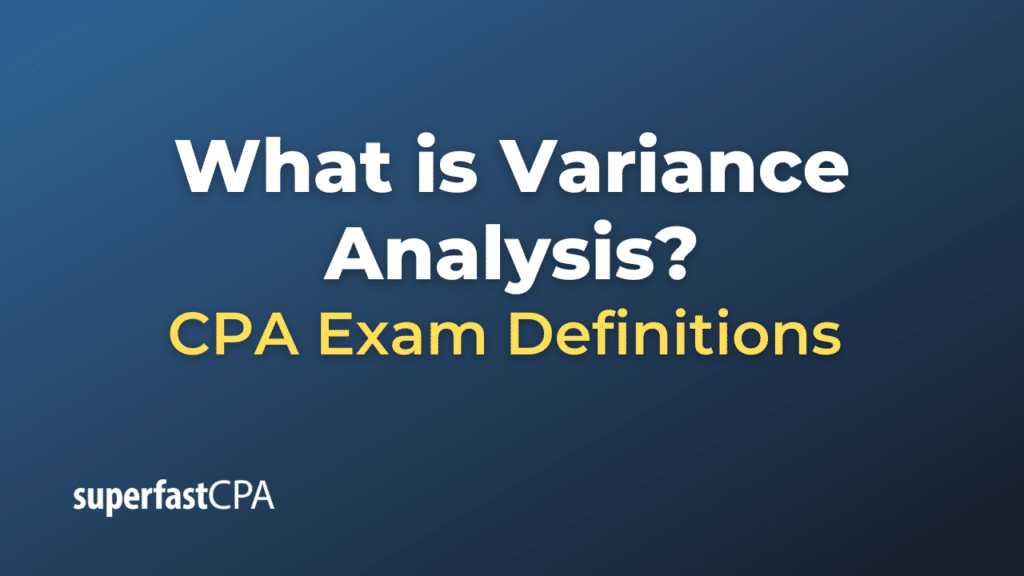Variance Analysis
Variance analysis is the quantitative investigation of the difference between actual and planned behavior. This analysis is used to maintain control over a business. For example, if you budget for your department to spend $100,000 a month, and the actual monthly spending is consistently $110,000, a variance analysis sets out to answer the question of why there is a difference of $10,000 between planned and actual spending.
Variance analysis is often used in:
- Financial Analysis: Examining variances between actual and budgeted financial figures such as revenue, expenses, and income.
- Operations Management: Assessing performance metrics like production volume, labor efficiency, material usage, etc., against expectations.
- Project Management: Comparing planned project timelines, costs, and deliverables against actual results to identify discrepancies.
- Quality Control: Analyzing deviations in quality metrics to determine their causes and rectify them.
Types of Variances:
- Cost or Spending Variance: Difference between actual costs and budgeted costs.
- Volume or Activity Variance: Difference between actual output and planned output.
- Revenue or Sales Variance: Difference between actual revenue and projected revenue.
- Efficiency Variance: Measures how efficiently resources like time and materials are used, compared to what was planned.
- Price Variance: Difference between actual prices and budgeted or standard prices for goods or services.
Steps in Variance Analysis:
- Identify the Variance: Compute the difference between the actual result and the planned or standard figure.
- Categorize the Variance: Determine if the variance is favorable (e.g., higher actual revenue than expected) or unfavorable (e.g., higher actual costs than budgeted).
- Analyze the Causes: Investigate why the variance occurred. This could involve discussions with team members, reviewing operational data, or analyzing market conditions.
- Take Corrective Action: Depending on the cause, corrective action could include revising budgets, re-allocating resources, or changing operational processes.
- Report and Monitor: Variance analysis findings are usually reported to management, and corrective measures are monitored for effectiveness.
Example of Variance Analysis
Let’s consider a simplified example involving a small business that sells handmade soap.
Scenario:
You own a soap-making business and had planned a budget for the quarter. Your plan was to produce and sell 1,000 bars of soap, with an expected cost of $2 per bar for materials and labor.
Budget:
- Expected number of bars to sell: 1,000 bars
- Expected cost per bar: $2
- Total budgeted cost: 1,000 bars x $2/bar = $2,000
Actual Results:
At the end of the quarter, you find that:
- You actually produced and sold 1,100 bars of soap.
- The actual average cost was $2.10 per bar.
- Total actual cost: 1,100 bars x $2.10/bar = $2,310
Variance Analysis:
1. Identify the Variance:
- Cost Variance: $2,310 (actual cost) – $2,000 (budgeted cost) = $310
- Volume Variance: 1,100 bars (actual) – 1,000 bars (expected) = 100 bars
2. Categorize the Variance:
- Cost Variance: Unfavorable, as the actual cost is more than the budgeted cost.
- Volume Variance: Favorable, as more bars were sold than expected.
3. Analyze the Causes:
- For the Cost Variance: Perhaps the price of raw materials went up, or maybe labor costs were higher than planned.
- For the Volume Variance: Maybe a marketing campaign was more successful than anticipated, or perhaps there was increased seasonal demand.
4. Take Corrective Actions:
- For the Cost Variance: Negotiate with suppliers for better rates or optimize the production process to reduce costs.
- For the Volume Variance: Since it’s favorable, consider how to maintain or further improve sales. Could you expand the successful marketing campaign, for example?
5. Report and Monitor:
- Prepare a report detailing these variances and actions taken to correct them.
- Continue to monitor costs and sales closely in the next quarter to see if corrective actions are effective.
In this example, the cost variance alerted you to the fact that production is more costly than planned, which may require action if it continues. The volume variance, on the other hand, indicates stronger-than-expected sales, but it might also require adjustments in your operations to meet the higher demand efficiently.
This is a simplified example but should give you an idea of what variance analysis involves and how it can be useful for businesses in understanding their performance against their plans.













